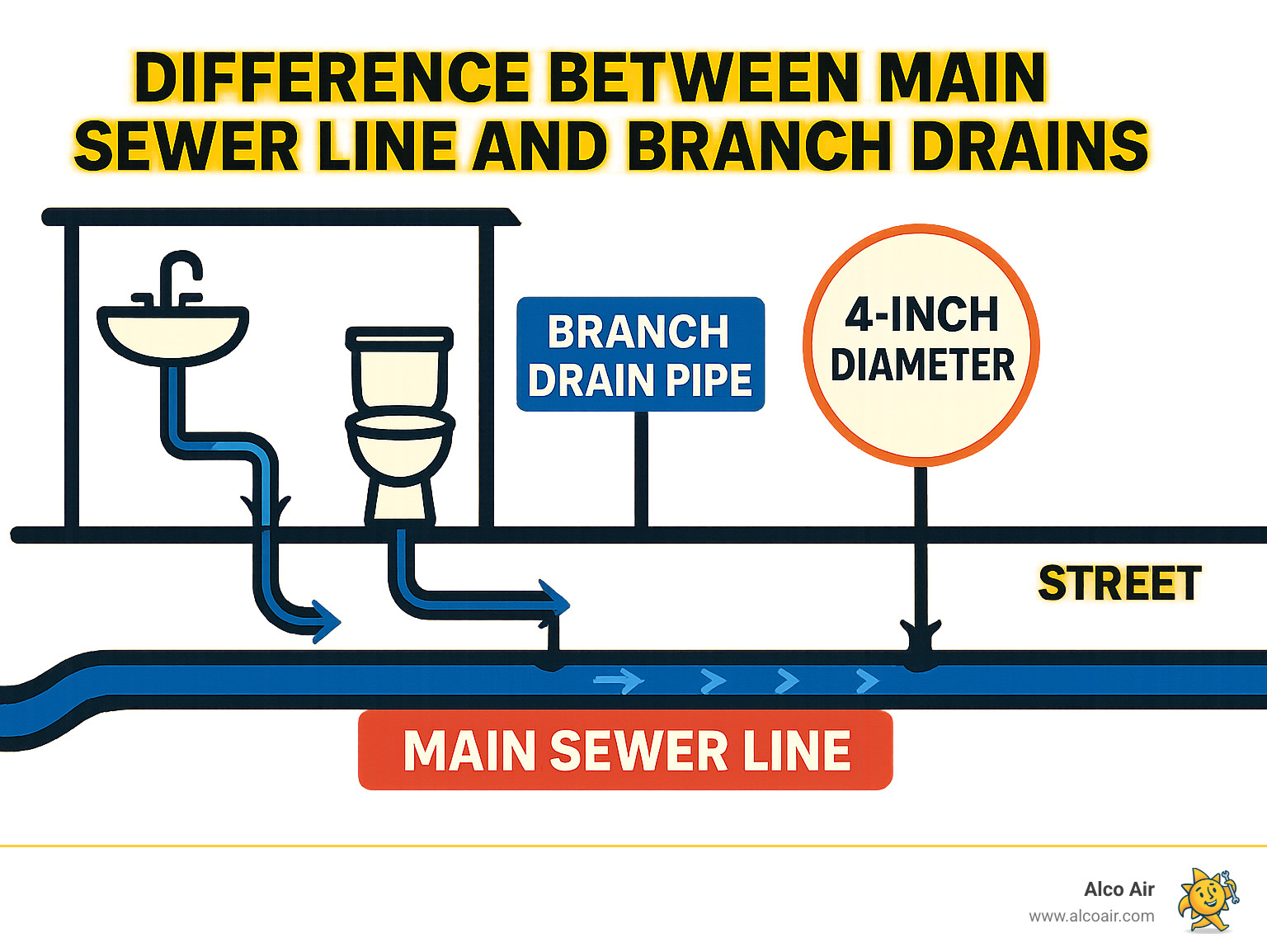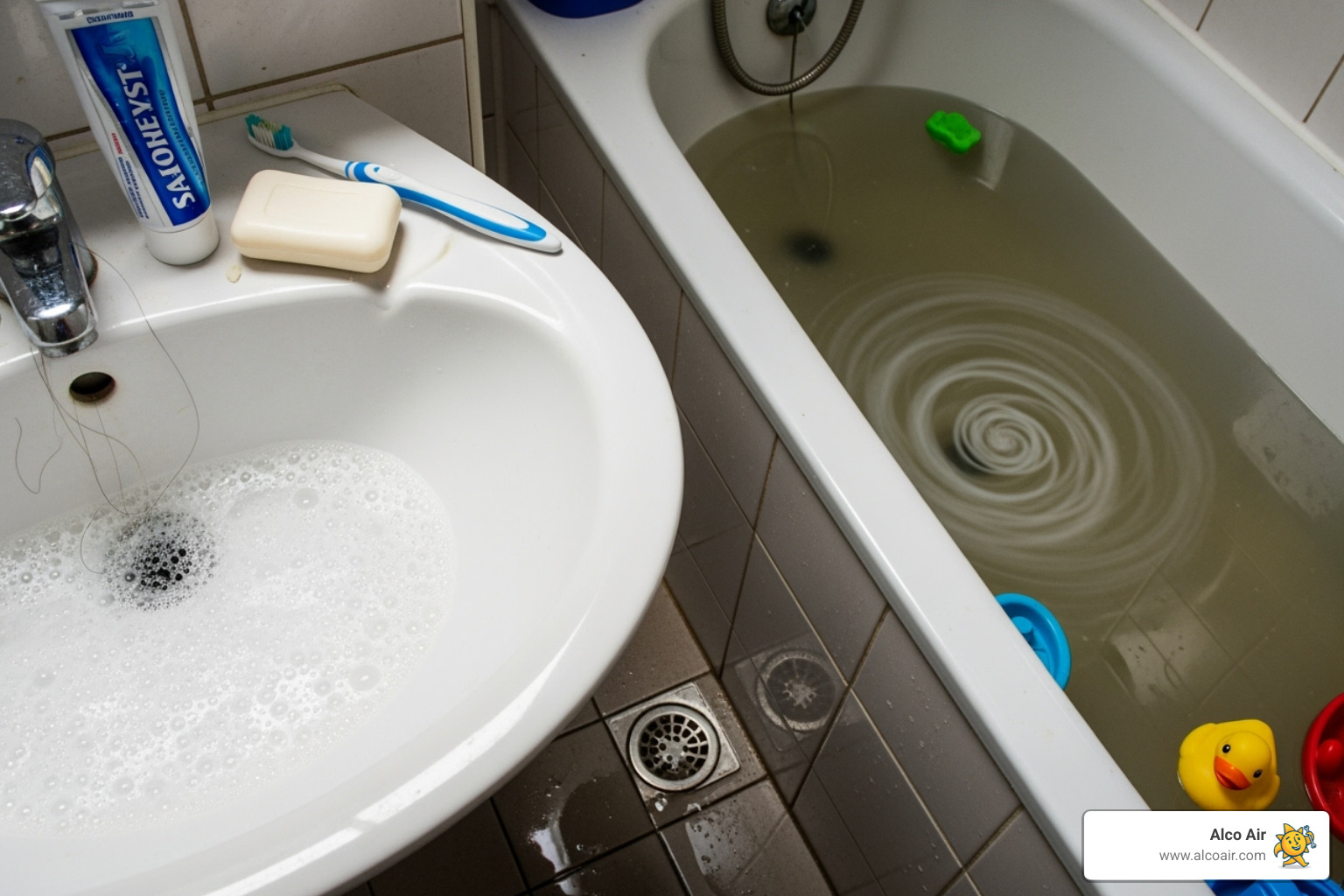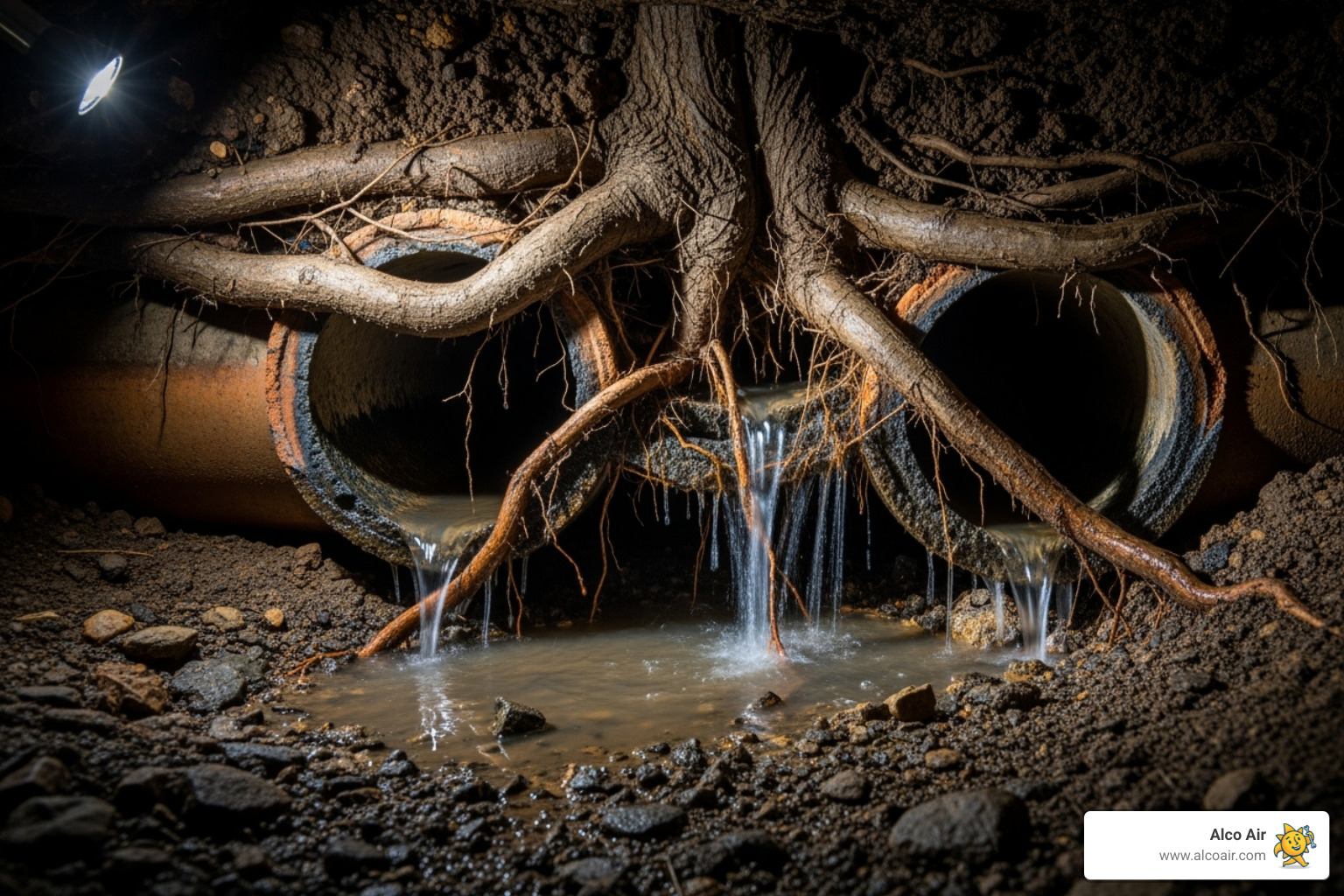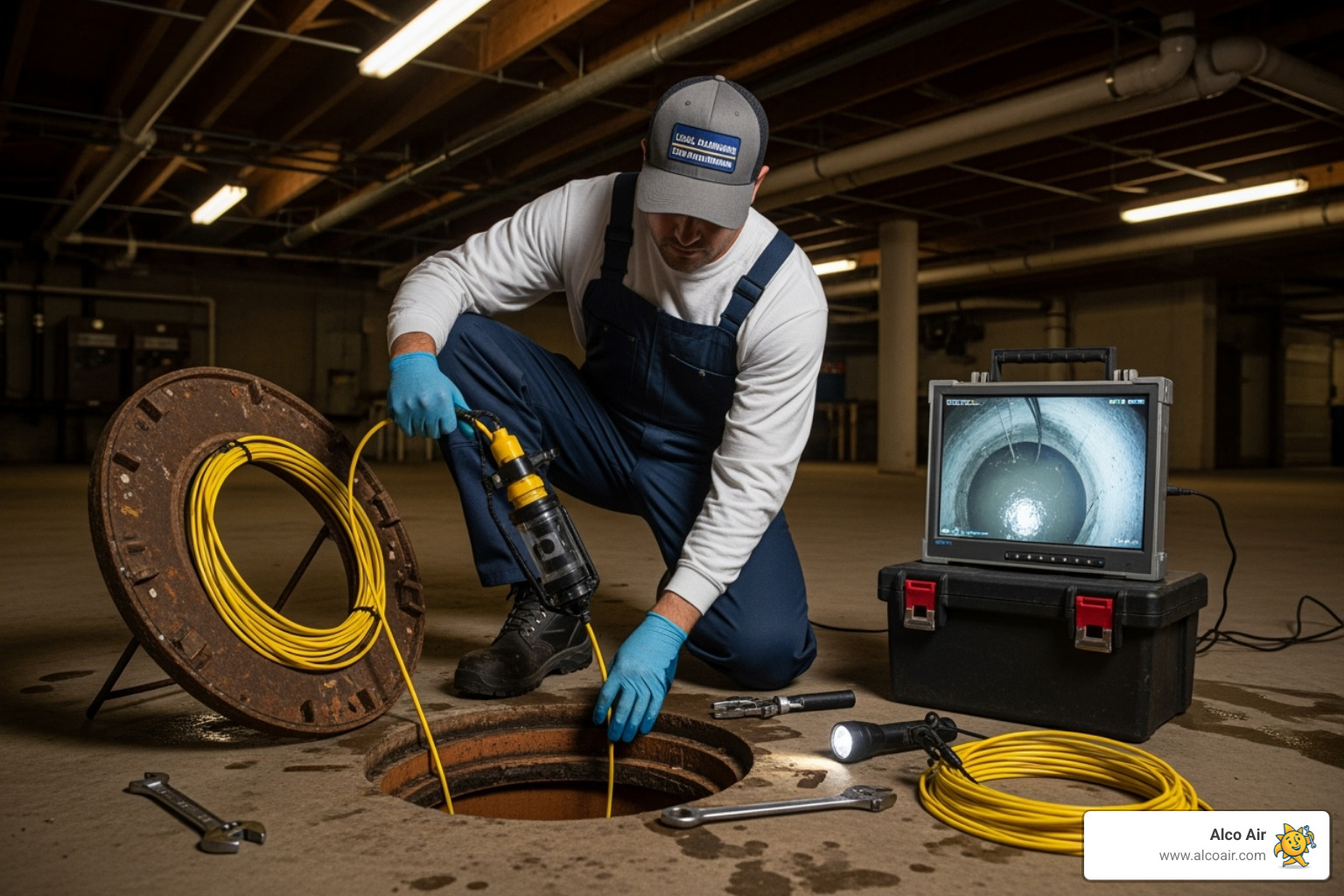Why Understanding Sewer Line Clogs Matters for Your Home
A clogged sewer line can escalate from a minor issue to a major disaster, leading to property damage, health hazards, and expensive repairs. When your main sewer line backs up, you’re not just dealing with a slow drain—you’re facing a system-wide failure.
Quick Answer: Signs Your Sewer Line is Clogged:
- Multiple drains backing up at the same time
- Water backing up in odd places (like shower when toilet flushes)
- Gurgling sounds from toilets and drains
- Sewage smells throughout your home
- Water or sewage in floor drains
- Standing water in your sewer cleanout pipe
Your home’s plumbing system works like a tree: the main sewer line is the trunk, and individual drains are branches. A single clogged drain only affects that “branch.” But a clogged main sewer line impacts your entire plumbing system.
The difference is critical. Research shows that ignoring main sewer line clogs can lead to costs upwards of $1,000 to dig up your yard and clear the blockage. Even worse, sewage backups create serious health risks from harmful bacteria.
The good news? Most sewer line clogs are preventable with proper habits and early detection. Understanding the warning signs helps you catch problems before they become plumbing emergencies.
How to Tell if Your Main Sewer Line is Clogged
When you flush the toilet and water bubbles up in your shower, your home is sending an SOS signal about a clogged sewer line. The key is to determine if you’re dealing with a simple drain clog or a full-blown sewer line blockage that needs professional attention.
Clogged Drain Pipe vs. Clogged Sewer Line
A single clogged fixture—like a slow bathroom sink—is a localized issue. Hair or soap buildup is a likely culprit. A sewer line clog is different. Since the main line carries wastewater from your entire house, a blockage causes multiple fixtures to act up simultaneously.
| Sign of Clog | Single Drain Clog | Main Sewer Line Clog |
|---|---|---|
| Fixtures Affected | Just one sink, toilet, or shower | Multiple drains throughout the house |
| Water Backup | Only in the problem fixture | Water appears in unexpected places |
| Sounds | Gurgling from that one drain | Gurgling from toilets when using other fixtures |
| Odors | Mild smell from the affected drain | Strong sewage odors throughout the home |
| Sewer Cleanout | Cleanout pipe looks normal | Water or sewage visible in outdoor cleanout |
| Yard Signs | No outdoor symptoms | Soggy spots or extra-green grass near sewer line |
Key Warning Signs of a Blockage
Your home communicates serious problems through these red flags:
Multiple slow drains are a clear sign of trouble. When your kitchen sink, bathroom sink, and toilet all drain slowly, the blockage is deep in your main line.
Gurgling noises from toilets indicate trapped air. If you flush and hear gurgling from a shower drain, or run water in the sink and your toilet makes strange sounds, air is escaping through other fixtures because the main line is blocked.
Water backing up in odd places is an alarming sign. If you flush your toilet and water appears in your bathtub, it’s because wastewater has nowhere to go and is taking the path of least resistance—usually the lowest drains in your home.
Sewage backing up in a floor drain (common in basements or utility rooms) is a definitive red flag that your main sewer line is blocked.
Your sewer cleanout pipe—the capped pipe outside your home or in your basement—is a great diagnostic tool. If you see water standing in the cleanout or sewage draining from it, you’ve confirmed a main line clog. Be careful when checking this, as there can be significant pressure behind the cap.
Catching these signs early can save you from the nightmare of sewage backing up into your home.
Common Causes of a Clogged Sewer Line
Most sewer line blockages happen gradually and are often preventable once you know what to watch out for.
Debris, Grease, and Foreign Objects
Your sewer line is only designed to carry wastewater. Sending other items down the drain can cause a serious buildup.
Fats, oils, and grease (FOG) are the biggest culprits. When hot grease cools in your pipes, it hardens and builds up, creating a sticky trap for other debris. Grease contributes to nearly half of all sewer overflows in the U.S.
“Flushable” wipes are highly misleading. They don’t break down like toilet paper and instead tangle together, forming massive blockages that require professional removal.
Feminine hygiene products, paper towels, and cotton swabs are designed to absorb water, not dissolve in it. Flushing these items will eventually create a dam in your line. Even hair combines with soap scum to form thick, stubborn mats.
Food waste also creates problems. Starchy foods like potato skins, rice, and pasta expand with water, while coffee grounds and eggshells create a thick sludge that coats pipes.
To protect your pipes, never flush or put these items down the drain: fats, oils, and grease; any type of wipes (even “flushable” ones); feminine hygiene products; paper towels and tissues; cotton balls and swabs; dental floss; hair clumps; coffee grounds; eggshells; fruit and vegetable peels; pasta, rice, and beans; medications; and any paint, chemicals, or automotive fluids.
Pipe Damage and Environmental Factors
Sometimes a clogged sewer line is caused by factors beyond your control.
Tree root intrusion is a common issue. Tree roots seek out water and can enter your sewer line through the smallest crack. Once inside, they grow into a thick, tangled mass that blocks the entire pipe.
Shifting soil from heavy rains, droughts, or freeze-thaw cycles can crack or disconnect sewer pipes, especially older clay pipes with deteriorating joints.
Pipe corrosion affects older cast iron or galvanized steel pipes, which rust from the inside out. This creates rough surfaces that snag debris and reduces the pipe’s diameter, making clogs more likely.
Pipes can also break or collapse due to age, soil movement, or external damage, causing a complete system shutdown that requires immediate attention. Old plumbing systems in general may not be able to handle the volume of modern household waste.
If your home has a septic system, problems with the tank or drain field can cause similar backups. Learn more about How Your Septic System Works to understand your home’s wastewater management.
How to Address a Sewer Line Blockage
When facing a clogged sewer line, it’s crucial to know when to call for professional help. Main line clogs are far more serious than a simple sink backup.
Before attempting any fix, turn off your main water supply to prevent further backup and potential flooding. This simple step can prevent a messy situation from becoming a disaster.
DIY Methods for a Minor Clogged Sewer Line and Their Risks
While it’s tempting to try a DIY fix, most methods are ineffective for main line clogs and can make the problem worse.
- Plungers: Useless against main line blockages. The force can push debris further into the system, making the clog harder to remove.
- Chemical drain cleaners: These harsh chemicals can damage pipes, especially older or PVC lines, and pose serious health risks from chemical burns and toxic fumes. If they fail to clear the clog, you’re left with caustic chemicals sitting in your pipes.
- Boiling water: May work on minor grease clogs in a kitchen sink but is ineffective for a main line clog and can crack PVC pipes or porcelain fixtures.
- Baking soda and vinegar: This is the safest DIY option but lacks the power to clear a serious blockage.
Attempting to clear a main sewer line yourself exposes you to raw sewage, which contains harmful bacteria and gases. Without proper safety precautions and professional equipment, you risk your health.
Professional Solutions for a Major Clogged Sewer Line
Professional plumbers use specialized tools to diagnose and resolve the problem safely and effectively.
Sewer camera inspection is the first step. A high-resolution camera is fed into your sewer line to pinpoint the exact location and cause of the blockage, eliminating guesswork.
Hydro jetting is a highly effective solution that uses water pressurized to over 3,000 PSI to blast away stubborn blockages like grease, sludge, and even tree roots. It’s environmentally friendly and thoroughly cleans pipe walls.
A professional auger (snake) is a powerful, motorized tool that can break through solid obstructions or retrieve foreign objects from the line.
If the camera reveals pipe damage, trenchless repair methods like pipe relining can fix damaged sections without extensive excavation. In cases of severe damage or collapse, pipe replacement may be necessary.
The cost of drain clearing varies based on the clog’s severity and location. Early intervention is key, as waiting until excavation is needed significantly increases costs. As research shows, drainage systems can be an occluded source of sanitation-related outbreaks, making professional handling of sewer issues a matter of public health.
Best Practices for Preventing Future Clogs
The best way to deal with a clogged sewer line is to prevent it from happening. Most prevention strategies are simple daily habits that protect your plumbing and save you from costly repairs.
Daily Habits and Proper Disposal
Your daily habits in the kitchen and bathroom directly impact your sewer line’s health.
In the kitchen, the golden rule is to keep food and grease out of your drains. Scrape plates clean into the trash before washing.
Grease disposal is critical. Never pour fats, oils, or grease down the drain. Let it cool and solidify in a container (like an old coffee can), then throw it in the trash.
Use drain strainers in all sinks, showers, and tubs to catch hair, soap scum, and food particles. Clean them regularly.
Use your garbage disposal sparingly and always with plenty of cold water. Avoid putting in fibrous foods (celery), starchy items (pasta, rice), or coffee grounds.
In the bathroom, the most important rule is to only flush toilet paper. Despite marketing claims, “flushable” wipes do not break down and are a primary cause of clogs. The same applies to feminine hygiene products, cotton swabs, and dental floss. Your toilet is not a trash can.
Proactive Maintenance and Inspections
Beyond daily habits, proactive maintenance is key to preventing major issues.
Regular professional inspections are like an annual checkup for your plumbing, especially if you live in an older home or have large trees on your property.
Camera inspections for older homes with clay or cast iron pipes can identify problems like root intrusion or pipe deterioration before they cause a backup.
If you have known issues with tree roots, root destroyer products can help manage growth between professional cleanings.
For ongoing maintenance, use enzyme cleaners monthly. These products use beneficial bacteria to gently break down organic buildup like grease and soap scum without harming your pipes.
A simple trick is to fill all sinks and tubs with water once a month, then drain them simultaneously. The surge of water helps flush minor debris from your lines.
Frequently Asked Questions about Sewer Clogs
Dealing with a clogged sewer line can be stressful. Here are answers to some of the most common questions homeowners have.
How much does it cost to clear a main sewer line?
There is no single price for clearing a clogged sewer line. The final cost depends on several factors:
- Severity of the clog: A minor, easily accessible blockage costs less to clear than a severe, compacted one.
- Location of the clog: A clog deep underground will be more difficult and costly to reach than one near the cleanout access point.
- Nature of the clog: Heavy grease or tree roots may require more intensive methods like hydro jetting, which can affect the price.
- Pipe condition: If the pipe is damaged and requires repair or replacement, the cost will be significantly higher than a simple clearing.
Early detection and prevention are the best ways to avoid high costs.
Who is responsible for a clogged sewer line?
Responsibility for a clogged sewer line depends on the clog’s location.
- The Homeowner: You are responsible for your “sewer lateral,” the pipe running from your house to the municipal sewer main (usually under the street). If the clog is anywhere in this section, the repair is your responsibility.
- The Municipality: The city or county is responsible for the municipal sewer main, the large public line that collects wastewater from multiple homes.
If your neighbors are experiencing similar issues, the problem is likely in the municipal main, and you should contact your local utility. If only your home is affected, the clog is almost certainly in your private sewer lateral.
How often should I have my sewer line inspected?
How often you need an inspection depends on your home’s age and property features.
- Older Homes (pre-1970s): Homes with original clay or cast iron pipes should be inspected every 1-2 years, as these materials are prone to cracks and root intrusion.
- Homes with Large Trees: If you have mature trees near your sewer line, an annual inspection is wise. If you have recurring root problems, consider inspections every six months.
- Recurring Issues: If you experience frequent clogs, an annual camera inspection can help identify underlying problems.
- General Recommendation: For most modern homes without specific risk factors, a professional inspection every 2-5 years is a great preventative measure that provides peace of mind.
Protect Your Home from Sewer Backups
Ignoring the signs of a clogged sewer line can lead to costly repairs, widespread water damage, and serious health risks from exposure to raw sewage. Don’t let a blockage turn into a disaster that floods your basement or fills your home with foul odors.
We understand that plumbing emergencies are incredibly stressful. At Alco Air, we have served Longview, Texas, and the surrounding areas for over 30 years, becoming experts at resolving even the most stubborn clogged sewer line issues.
Our NATE-certified technicians are equipped with advanced tools and the knowledge to accurately diagnose your sewer line problem and clear it efficiently. With our 4.8-star Google rating and a 100% money-back guarantee, you can feel confident in our service. Whether you’re facing an emergency blockage or need a routine inspection, we provide the fast, reliable help you deserve. Don’t let a clogged sewer line disrupt your life.
For professional drain cleaning services that you can trust to get your plumbing flowing smoothly again, reach out to us today.















